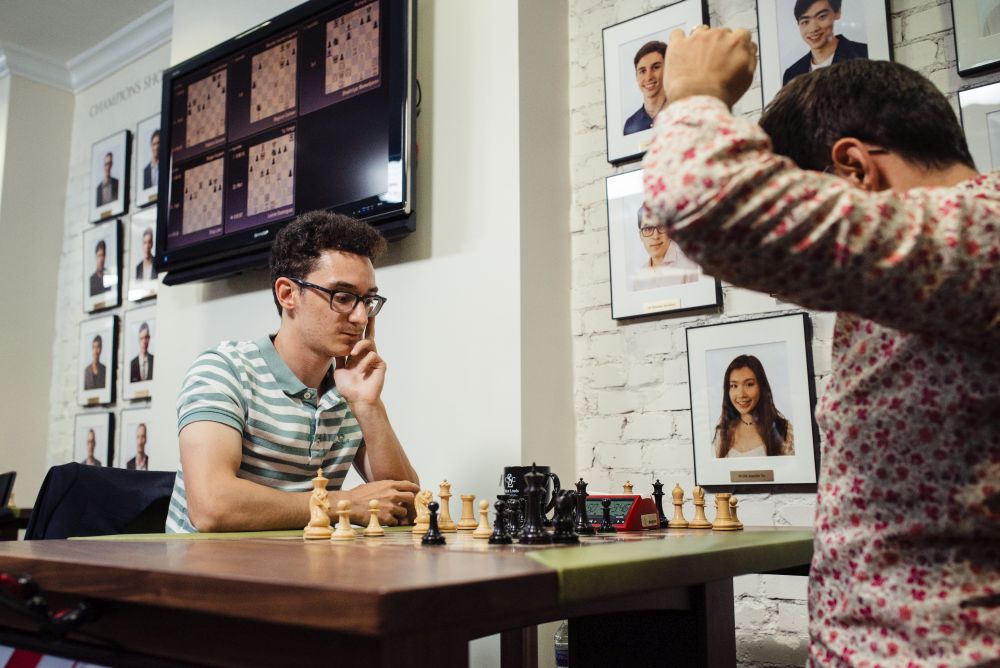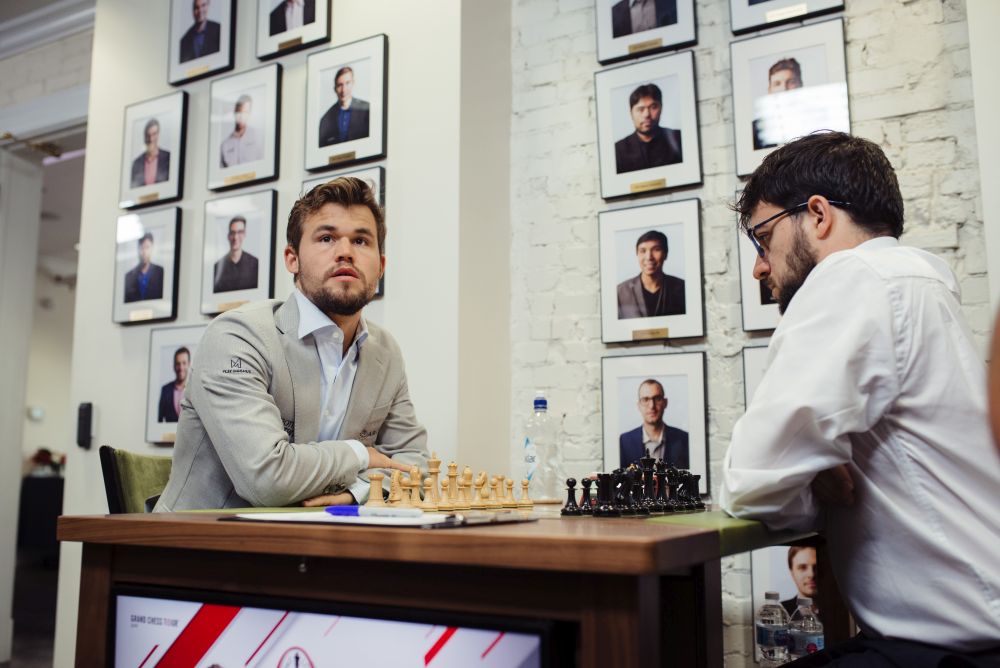


'Do you consider yourself as the favourite going into the Blitz in the next two days?' Maxime Vachier-Lagrave answers, “Of course!” and smiles largely. I can't help but admire his confidence as well as his directness, not bothering for false-modesty.
The Frenchman caught up with Levon Aronian on 13 points out of a possible 18 with a +4 score, and shares the lead going into the Blitz part for the last two days of the Saint Louis Rapid and Blitz. But it was not only his effort which saw him climb up to the podium — it was also a day which didn't go well for Levon Aronian, at least for the way he has played so far and how he started the day.
The seventh round of the Saint Louis Rapid presented a mouth-watering prospect — the top pack against each other: Fabiano Caruana vs Levon Aronian, and Magnus Carlsen vs Maxime Vachier-Lagrave. And the protagonists rose to the occasion, with two full-fledged fights in two memorable games.

The all important seventh round in progress | Photo: Crystal Fuller / Grand Chess Tour
Observing all the four players in the top two boards, it was impossible not to ignore the most glaring factor — their body language. At one end of the spectrum, you had Fabiano Caruana, almost unflinching throughout the game, not many traces of emotions on the face ever, and keeping everything under a cool cloud, almost. And then you have the world champion — grimacing on the board when he doesn't like any aspect of the position, generally giving an energetic appearance, suddenly getting up and (surprisingly) leaving for the loo at the beginning stages of a game, and shuffling pieces with his hand on the side of the board often during the game at many points.
Then you have Maxime Vachier-Lagrave, almost as cool as Caruana most of the time, but you can't help feeling that he struggles a little to maintain that exterior, as his hands which often cross his face show.

Caruana doesn't seem to mind Aronian's maneurisms | Photo: Austin Fuller / Grand Chess Tour
Then you have Levon Aronian, with a mostly impassive face, but not stationary on the board always, chest-heaving (!) being his favourite gesture. And Aronian had all the reasons for being happy with himself — everything seemed to be going well for him from the beginning of the day, surprising Caruana with a prepared novelty on the tenth move:
10...♝e6
Hasn't been played at the very top in recent times. A surprise in the opening is always an important psychological device, in a proper opening, instead of a 'setup'. From the body language of the players, it appeared that Aronian was quite pleased with the game at this point. Caruana had played a game recently in the line, which probably enabled Aronian to 'target' him here.
Here, 22.♖ca1 or 22.♘b3 are perfectly fine — apart from targeting pawn-a5, Black doesn't have much of strength in the position, which means White should be mildly better here. He holds most of the cards — space advantage and generally better pieces. But Caruana decided to get risky, and sacrificed the pawn:
22.♕d3!? ♞xa5 23.♖ac3 ♞d7!
Thus Black developed the knight because of the simple trick 24.♖xc7? ♞xe5!
Somewhere around here, Caruana's position didn't look very encouraging. After sacrificing the pawn, though he holds enough compensation, it is difficult to suggest something tangible for him to do, which became obvious in the further course of the game.
28.♘h2?
Finally Caruana loses his composure and errs, probably unnerved that his position wasn't moving anywhere. Better was 28.g3!? Simply, not changing his piece position and giving room for his king at g2 and awaiting black's actions ♞b7 29.♘b1 aiming for ♘b1-c3-a4 and keeping a tight leash on the c5-square. But it is a different story whether it was possible to play this way in a rapid game with limited time at your disposal.
30.♖c3?
Under pressure his compensation for the pawn has vanished and he is no more controlling the board, Caruana cracks and hands over Aronian a clearly better position. Better was 30.♕d3 ♞c6 31.♘hf3 — No other choice but to bring the knight back, and hope for the best, though black is a healthy pawn up and on top here. Aronian went on to win comfortably from here.
Disappointingly for the spectators, the other game too went the same way — Magnus Carlsen getting an upper hand from the opening and coasting home without letting up:
8.h3!?
8.♗e2 is the regular move here.
11.♖c1 — a new move. "I didn't expect him to go for this line, and it seems I didn't find the best way", confessed Vachier-Lagrave after the game.
11...♞d7?!
The cleverness of Carlsen's preparation is that, there is almost only one way for black to respond here: 11...f5!? 12.e5 f4 13.♗d2 ♝e6 with a complex position. It is perfectly natural that even a top player of the world like Vachier-Lagrave may not be able to find it on any given day, gives us an idea about the thinking which went into Carlsen's preparation.
From thereon, Carlsen took over the initiative and started increasing pressure on black's position. Further on, there was only one chance for Vachier-Lagrave to bounce back:
This was precisely the moment when Vachier-Lagrave probably had a final chance to create play with a sacrifice: 15...bxc6!? almost the only way where black could have fought back in the game, after he missed his chances in the opening stages 16.♘bxd4 exd4 17.♗xd4 ♝xd4 18.♘xd4 ♜e8 and though white is still better, there is considerable amount of counterplay for black, especially in a rapid game. But he went wrong with
15...♞xc6? 16.♗e2 ♞f6 17.♖d1 and Carlsen built up his advantage slowly to force an overwhelming position.
When I asked him after the game whether he considered the sacrifices for black on the 15th move, he says he indeed saw both the moves, but felt that both were losing. And he wholeheartedly praised Carlsen's play after this point.

Magnus Carlsen – Clever opening choice | Photo: Austin Fuller / Grand Chess Tour
Thus, even though the top board clashes were important in terms of the tournament standings, they weren't really riveting encounters, as both Carlsen and Aronian didn't encounter all out resistance from their opponents.
And another board, another brilliant creative player of our times finally had his time under the sun:
Black is already winning here, but the finish was quite pretty.
16...♞xd5! 17.exd5 ♛f6 18.0-0-0 ♛f4 19.♘e2 ♛b4 and Black went on to win.

Place under the sun — Richard Rapport interviewed by Maurice Ashley | Photo: Austin Fuller / Grand Chess Tour
Thus, after seven rounds, it looked like Aronian was sitting pretty at the top with 12 points trailed by Vachier-Lagrave on 9 — a full 3 point lead!
Asked by Maurice Ashley if he was very happy, Levon Aronian answered cautiously "I am just happy, not very happy. I will be very happy if I have a three-point lead in three days!"

Levon Aronian — Happy, but not very happy | Photo: Crystal Fuller / Grand Chess Tour
Of course, things started rolling on, with a major drama taking place in the very next round.
Here, Aronian started repeating the position with 26...♛d1+ 27.♔h2 ♛d6+ 28.♔g1 ♛d1+ 29.♔h2 ♛d6+ and just when everyone had assumed that the game was about to end with a peace treaty — after all, wasn't Rapport a 'tail-ender' playing the tournament leader?! — Rapport played.
30.g3! The courage! After all, he might just have scored two wins, a solitary draw and four losses in this particular tournament, but we have to remind ourselves that Richard Rapport has his class, and this is the Grand Chess Tour, after all!
Probably losing his bearings, in a momentary slip, Aronian continued:
30...♛f6?
The only way to survive was 30...e3! 31.fxe3 ♛d1! and White's exposed king should allow Black to create a draw by perpetual check at some point.
31.♕xc4+ ♚h8 32.♕e2 and White gained a considerable advantage.
Suddenly having to defend an unpleasant ending, Aronian's next slip was almost imperceptible:
35...♜f8?
As all the basics of rook endings validate, the best way to hold this position was to active the black rook: 35...♜e4! 36.♖b3 h5 37.♔xf2 h4 38.g4 ♚g8 and the story is still not over.
36.♔f1 The problem for black now is that, white can easily hunt down the c6-pawn 36...h5 37.♖a5 g6 38.♖a6! and white is already winning.
Rapport's shaky conversion against Aronian | Video: V Saravanan
Thus, Rapport got to shake the tournament up fully, pulling down the tournament leader. How did he feel after the game?
Rapport admitted:
I had a really rough start even before the tournament, my flight getting cancelled, and (arriving) only on the midnight before the starting day of the tournament and feeling jetlagged. I think I have started to getting into better shape!
And elsewhere, Aronian's closest rival Vachier-Lagrave was facing the supposed curse of modern chess, The Berlin Defence! But the Frenchman showed us all how to play this particular endgame:
22.e6! Beautiful! More than the concept itself, it is for being in the forefront of the war against such stubborn forces, that Vachier-Lagrave should be praised! 22...fxe6 23.♗f4! and white gains an overwhelming advantage due to black's uncoordinated pieces. The next blow was simple but even more beautiful.
26.♗xb6! and White went on to win.
This game seemed to be model of 'How to beat the Berlin'! Half the world is tired of the Berlin, but he seemed to do it very easy in this game? How did he do it? I made it a point to catch him at the end of the day and ask him the important question.
This is when I got a glimpse of the Frenchman's class — he came with a unique and fantastic viewpoint:
Black players use the fact that white doesn't want to go for the endgame in general. But when it happens, it is generally difficult. Of course, sometimes I win (in the Berlin endgame), sometimes I draw, and I rarely lose. But it is very very difficult in Rapid and Blitz (formats) to defend these endgames with black. But no one is ready to go for the endgame with white! And being one of the remaining fews (who play the endgame), it gives me an advantage that (black players) are mostly checking the Anti-Berlins, and when they have to play the endings, it is not easy for them!
'So you are happy playing the Berlin Endgames in Rapid and Blitz?'
“I am not doing badly!!"
This is top class wisdom and psychology, coming from one of the best in business!
And elsewhere in the tournament hall, the match-up between two who fought for the supreme title just three years ago was a tense affair:
28...♛xc6? An inexplicable concession, creating a monster for black at c6, that too in a thankless position where black is doomed to passivity. Though the game had its ups and downs further on, Karjakin's win was never in doubt.

Sergey Karjakin – World Championship flashback | Photo: Crystal Fuller / Grand Chess Tour
Final moments of Karjakin's win against Carlsen | Video: V Saravanan
And this was Carlsen's fourth loss in a tournament — when did that ever happen before?!
So, with one last round to go, the points table at the top was:
The last round was not much of action-packed, but there was a moment of fun:
Now, how many of you seen such positions in a world champion's game!?

Shakhriyar Mamedyarov — a moment of fun | Photo: Crystal Fuller / Grand Chess Tour
The leader Levon Aronian could not make much headway against Yu Yangyi, and hence came Vachier-Lagrave's opportunity.
Just when it looked like white was forced to continue 21.♗xg6 ♛xb3 22.♗h7+ ♚h8 23.axb3 ♝h6 24.♘df3 f6 25.♘e6 ♚xh7 26.♘xf8 ♝xf8 and the resultant imbalance forced Caruana unexpectedly into:
21.♕f3? Fabiano gives up the pawn for no clear reason, just like in his game against Aronian! 21...♛xd4 22.♖ad1 ♞f6 23.♘b3 ♛e5 24.h4 ♞xe4 and Black already had a winning position.
When I mention to Vachier-Lagrave that he made it look so easy in this game, out came another professional rejoinder:
I have played this exact position as white. So I knew it was playable for black, I had checked it as not giving anything tangible for white. And it looked a little dangerous for white also, as there are a few weaknesses (for him), and he didn't manage to create an attack for white on the kingside which he didn't manage in this game.
After that win, it turns out that Maxime Vachier-Lagrave becomes the top rated rapid player in the world with a live rating of 2867, upstaging Magnus Carlsen's 2855.
And this is when he expressed his confidence in winning the tournament now that the blitz part starts from tomorrow.
The rapid tournament scoring system is 2 points for a win and 1 point for a draw.
Live commentary by GM Yasser Seirawan, GM Maurice Ashley and WGM Jennifer Shahade from 18:00 UTC (20:00 CEST, 14:00 EDT)